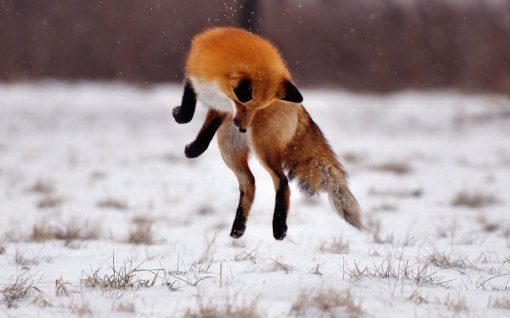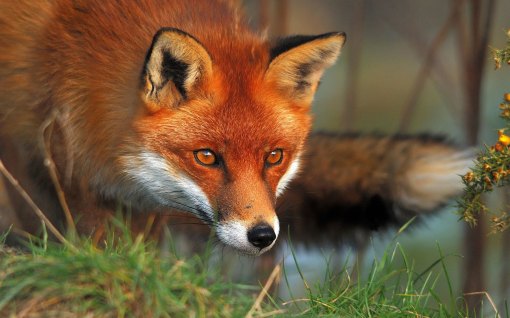The red fox (Vulpes vulpes) is the largest of the true foxes and the most abundant member of the Carnivora, being distributed across the entire Northern Hemisphere from the Arctic Circle to North Africa, Central America and Asia. Its range has increased alongside human expansion, having been introduced to Australia, where it is considered harmful to native mammals and bird populations. Because of these factors, it is listed as Least Concern by the IUCN.Due to its presence in Australia, it is included among the list of the “world’s 100 worst invasive species”.
***
Red foxes live around the world in many diverse habitats including forests, grasslands, mountains, and deserts. They also adapt well to human environments such as farms, suburban areas, and even large communities. The red fox’s resourcefulness has earned it a legendary reputation for intelligence and cunning.
Red foxes are solitary hunters who feed on rodents, rabbits, birds, and other small game—but their diet can be as flexible as their home habitat. Foxes will eat fruit and vegetables, fish, frogs, and even worms. If living among humans, foxes will opportunistically dine on garbage and pet food.
Like a cat’s, the fox’s thick tail aids its balance, but it has other uses as well. A fox uses its tail (or “brush”) as a warm cover in cold weather and as a signal flag to communicate with other foxes.
Habitat
Red Foxes have the widest range of any terrestrial carnivore. They are found in Europe, Canada, USA, Asia, Australia and North Africa. They have dens in forests, scrubland and prairies and they are becoming increasingly common in urban environments in Europe and North America. Red Foxes tend to be solitary although they have been known to group together in a pack. They are mainly active at dusk and during the night where they will forage around in their home territory. Their territories can range from 25 – 5000 acres (10 – 2000 hectares) and they mark them with urine and faeces. Foxes also signal each other by making scent posts—urinating on trees or rocks to announce their presence.
Diet
Red Foxes are omnivores and their diet mainly consists of rodents, insects, worms, eggs, birds, fruit and other small mammals. Urban foxes scavenge through household waste and will eat from pet food bowls that have been left outside. Red Foxes consume on average 0.5 – 1 Kg (1 – 2 lbs) of food per day and they will keep any surplus food near to their den to eat later. Red Foxes have an excellent sense of hearing and they will stalk and pounce on their prey. To kill their prey they will severe the spinal cord with their teeth.
Breeding
In winter, foxes meet to mate. The vixen (female) typically gives birth to a litter of 2 to 12 pups in a den. At birth, red foxes are actually brown or gray. A new red coat usually grows in by the end of the first month, but some red foxes are golden, reddish-brown, silver, or even black. When they are born they are blind and weigh approximately 150 g (5.3 oz). They open their eyes by the time they reach 2 weeks old and by 5 weeks they have left the den for the first time. The cubs are weaned when they are 7 – 9 weeks old and by the autumn they all move away to find their own territories. They reach sexual maturity by the time they are one year old. Both parents care for their young through the summer before they are able to strike out on their own in the fall.
Predators
Predators of the Red Fox include humans, bears, wolves, and coyotes. Red foxes are hunted for sport, though not extensively, and are sometimes killed as destructive pests or frequent carriers of rabies.
Subspecies
As Red Foxes have such a wide range, they have many subspecies. Below are a list of subspecies and their locations:
Vulpes vulpes abietorum – Western Canada
Vulpes vulpes aeygptica – Egypt
Vulpes vulpes alascensis – Alaska
Vulpes vulpes alpherakyi – Turkestan
Vulpes vulpes alticola
Vulpes vulpes anatolica – Asia
Vulpes vulpes arabica – Muscat
Vulpes vulpes atlantica
Vulpes vulpes barbara – North West Africa
Vulpes vulpes beringiana – North East Siberia
Vulpes vulpes cascadensis – NW coast of USA
Vulpes vulpes caucasica – Caucasian Mount. area
Vulpes vulpes crucigera – Germany
Vulpes vulpes daurica
Vulpes vulpes diluta
Vulpes vulpes dolichocrania – Russia
Vulpes vulpes dorsalis
Vulpes vulpes flavescens – North Iran
Vulpes vulpes fulva – Eastern USA
Vulpes vulpes fulvus
Vulpes vulpes griffithi – Afghanistan
Vulpes vulpes harrimani – Alaska
Vulpes vulpes hoole – South China
Vulpes vulpes ichnusae – Sardinia
Vulpes vulpes induta – Cyprus
Vulpes vulpes jakutensis – Yakutsk
Vulpes vulpes japonica – Japan
Vulpes vulpes karagan – Khirgizia
Vulpes vulpes kenaiensis – Alaska
Vulpes vulpes krimeamontana – Crimea
Vulpes vulpes kurdistanica
Vulpes vulpes macroura – Rocky Mts, USA
Vulpes vulpes montana – Himalayas
Vulpes vulpes necator – Western USA
Vulpes vulpes ochroxanta
Vulpes vulpes palaestina – Palestine
Vulpes vulpes peculiosa – Korea
Vulpes vulpes pusilla – India
Vulpes vulpes regalis
Vulpes vulpes rubricosa – Canada
Vulpes vulpes schrencki – Sakhalin
Vulpes vulpes septentrionalis
Vulpes vulpes silacea – Spain
Vulpes vulpes splendidissima – Kurile Is.
Vulpes vulpes stepensis
Vulpes vulpes topolica
Vulpes vulpes tschiliensis – North East China
Vulpes vulpes vulpecula
Vulpes vulpes vulpes
Vulpes vulpes waddelli – Tibet
Interesting Facts
Foxes are often included in tales and folklore with a reputation of being sly and cunning.
Red Foxes are often known just by the name “Fox”
***
The red fox Distribution Map world wide.
















































I love foxes! In fact I love the fox and the hound because my autistic son is in love with that Disney film! There is a reflectors art work by Owen grommet. I am hoping to find one and buy it for him! Your pics remind me of the fox in that print! Thx for sharing!
LikeLike
Spectacular pictures!
LikeLike